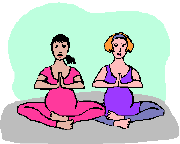 The following article is a small excerpt from one of my books. I hope you’ll want to learn more and let me help you to get into the best shape of your life.
The following article is a small excerpt from one of my books. I hope you’ll want to learn more and let me help you to get into the best shape of your life.

You have all heard the saying ‘you are what you eat.” Well along these same thoughts ‘you are also what you do!” Now if you are what you do, then your desire and drive to get in shape and better health, is not the result of a single act, but the result of habits. Not adding butter to your bread for just one day is not good enough! You must make the healthy lifestyle changes that will be come part of your daily routine.
The following tips are, proven and have been used by people who have been successful in their weight loss goals. You may have already heard of some of these tips but they are worth repeating because they work. You don’t have to do every tip all at once. Set yourself up on a schedule and try to implement one or two tips a week. Soon your new tips will be habit and part of your new improved lifestyle.
1. Add just one fruit or vegetable serving daily. When you get comfortable with that, continue to add an extra serving per day until you reach 8 to 10 servings per day.
2. Eat at least two servings of a fruit or veggie at every meal.
3. Never super size your food portions
4. Whenever you put food in your mouth, peel it, unwrap it, put it on a plate and sit down and enjoy. Enjoy all of your senses in the pleasure of nourishing your body.
5. Start your day off by eating a big breakfast. It helps you eat fewer total calories throughout the day.
6. Make sure your plate is half veggies and/or fruit at both lunch and dinner.
7. When dining out, eat only half and take the remainder home. A typical restaurant entree has 1,000 to 2,000 calories and that’s not even counting the bread, appetizers, beverages and dessert.
8. When dining out and you want desert, order only one and share it.
9. Use a salad plate instead of a dinner plate, a desert bowl instead of soup bowl and a juice glass instead of water tumbler.
10. See what you eat. Put your food on a plate or in a bowl instead of eating out of the jar or bag.
11. Eat the low-cal items on your plate first. Start with salads, veggies, and broth soups, and eat meats and starches last. By the time you get to them, you’ll be full enough to be content with smaller portions of the high-calorie choices.
12. Instead of whole milk, switch to 1 percent. If you drink one 8-oz glass a day, you’ll lose 5 lb in a year.
13. Juice has as many calories, ounce for ounce, as soda. Set a limit of one 8-oz glass of fruit juice a day.
14. Get calories from foods you chew, not beverages. Have fresh fruit instead of fruit juice.
15. Keep a food journal. It really works.
16. Eat until you are eight-tenths full.
17. Use mustard instead of mayo.
18. Eat more soup. But choose non-creamy soups, which are filling and lower in calories.
19. Cut back on or eliminate high calorie drinks such as soda, sweet tea, lemonade, etc. If you drink a 20-oz of soft drink every day, switch to the diet version or eliminate them completely and from just this one change you could lose up to 25 lb in a year.
20. Take your lunch to work.
21. Sit when you eat.
22. Dilute juice with water.
23. Have mostly veggies for lunch.
24. Eat at home.
25. Limit alcohol to weekends.
26. Have a V8 or tomato juice instead of a Diet soft drink for your afternoon drink.
27. If vegetables are boring for you to eat, try dribbling maple syrup over carrots or sprinkling chopped nuts on green beans.
28. Mix three different kinds of beans with some diet Italian dressing. Eat this three-bean salad all week.
29.Enjoy Vegetable soup because it does count as a vegetable.
30. Don’t forget the sweet potato.
31. Use baby spinach as lettuce in sandwiches, heated in soups, wilted in hot pasta, and added to salads.
32. If time is an issue, spend the extra few dollars to buy vegetables that are already washed and cut up.
33. If you really hate vegetables and love fruit, eat plenty of them. They are just as healthy (especially colorful ones such as oranges, mangoes, and melons).
34. Keep seven bags of your favorite frozen vegetables on hand. Mix any combination, microwave, and top with your favorite low-fat dressing. Enjoy 3 to 4 cups a day. Makes a great quick dinner.
35. The best portion of high-calorie foods is the smallest one. The best portion of vegetables is the largest one.
36. Your cravings will disappear after 10 minutes if you turn your attention elsewhere.
37. We all know the health risks of being overweight, so when you need to find some added motivation to stick to your plan think about wanting to be around to see not only your children grow up but there kids too. So pass on the sugar snacks for kids’ sake.
38. It’s not just a one-day, one-week, one-month obligation you are a work in progress, and will experience success and failure. Stick to it!!
39. It’s more stressful to be fat than to stop overeating.
40. Do not Skip meals. Many healthy eaters diet by day and binge by night. You are only fooling yourself.
41. Be careful of snacking. You can easily munch 600 calories of pretzels or chips without realizing it.
42. Watch your serving size. A serving of pasta is 1 cup, but some people routinely eat 4 cups and think that they are just eating one.
43. Avoid the super size bagels. Some have a calorie content of 400 to 500 calories per bagel.
44. Read the Serving Size on the Nutrition Facts panel on most food product.
45. Nuts are healthy but high with calories. Use nuts as a garnish instead of a snack.
46. All energy bars and fruit smoothies are not low in calories. Start to read and compare serving sizes and calorie content.
47. A smoothie made with fat-free milk, frozen fruit, and wheat germ (or protein powder) can be a great meal replacement. (I’m a big fan of using pineapple juice to replace the milk from time to time)
48. If it’s a fast food burger you crave, order the smallest fast-food burger (with mustard and ketchup, NO mayo) and drink water. You can add an apple or baby carrots to complete your meal.
49. Go back in time. Remember you lunch time meals when you were a kid? A peanut butter sandwich on whole wheat bread with a glass of 1 percent milk and an apple.
50. Precooked chicken strips with micro waved frozen broccoli topped with Parmesan cheese is also a quick and easy meal.
51. There are a lot of healthy frozen entrees available these days that make mealtime quick and easy. Choose one low in calories and enjoy with a salad and a glass of 1 percent milk.
52. I still love scrambled eggs in a nonstick pan (I use only egg whites). Pop some asparagus in the microwave and add whole-wheat toast and presto your eating in no time. If your cholesterol levels are normal, you can have seven eggs a week with the yolk, so if you mix egg whites with a whole egg that’s cool too.
53. A bag of frozen vegetables heated in the microwave, topped with 2 tablespoons of Parmesan cheese and 2 tablespoons of chopped nuts.
54. Pre-bagged salad topped with canned tuna, grape tomatoes, shredded reduced-fat cheese, and low-cal Italian dressing.
55. Keep lean sandwich fixings on hand like whole wheat bread, sliced turkey, reduced-fat cheese, tomatoes, mustard and horseradish.
56. Heat up a can of good soup. Or better yet, make your own soup and freeze serving sizes to have later.
57. Cereal, fruit, and fat-free milk makes a good meal anytime.
58. Try a veggie sandwich.
59. Precut fruit for a salad and add yogurt.
60. Don’t tell yourself, “It’s okay, it’s the holidays.” That opens the door to 6 weeks of splurging and added pounds with every party, cookie and drink.
61. Remember, EAT before you meet. Have a small meal before you go to any party like a hardboiled Egg, Apple, and a thirst quencher (water, seltzer, diet soda, tea) which will help you cut down on your alcohol consumption.
62. As obvious as it sounds, don’t stand near the food at parties. By doing this you’ll find you eat less.
63. At a buffet? Eating a little of everything guarantees you will eat more calories than you need. A good strategy would be to decide on three or four choices, only one of which is high in calories. Eat your high calorie choice last and you’ll find that you eat less.
64. For the duration of the holidays, wear your snuggest clothes that don’t allow much room for expansion. Wearing sweats is out until January.
65. After your company leaves, give away your leftover food to neighbors, doormen, delivery people, or take it to work the next day.
66. Walk around the mall three times before you start shopping.
67. Make exercise a nonnegotiable priority. You may lose weight while on some diets but long-term weight loss is accomplished and maintained by a balance of diet and exercise.
68. Dance to music with your family in your home and be active with your kids. It’s one of the easiest ways to involve the whole family in exercise.
69. If you have a sweet tooth and you just have to indulge, that’s all right. Have a lean salad for lunch or dinner, and save your main calories for a full dessert. Just don’t do this every day.
70. After going a few days without sweets, you will be able to avoid binging.
71. If you think you need a very sweet treat every night, try to strike a balance between healthy choices. Compromise with low-fat ice cream and fruit, or sometimes just fruit with a topping of whipped cream.
72. Try 2 weeks without sweets. It’s amazing how your cravings vanish.
73. Eat more fruit. If you get enough fruit in your diet chances are your won’t have a raging sweet tooth.
74. Eat your sweets, but limit them to about 150 calories per day for your favorite sweet. That amounts to about an ounce of chocolate, half a modest slice of cake, or 1/2 cup of regular ice cream.
75. Try these smart little sweets: sugar-free hot cocoa, frozen red grapes, fudgsicles, sugar-free gum, Nutri-Grain chocolate fudge twists, Tootsie Rolls, and hard candy.
76. Eat breakfast, lunch, and dinner. If you miss one of these meals, there is a high chance that you will struggle with nighttime eating and binging.
77. Eat your evening meal in the kitchen or dining room sitting down at your table.
78. Drink cold unsweetened raspberry tea. It tastes great and keeps your mouth busy and you won’t binge eat while watching your favorite show.
79. Change your nighttime schedule. It will take effort, but it will pay off. You need something that will occupy your mind and hands. Maybe find a hobby.
80. If you’re eating at night due to emotions, you need to focus on getting in touch with what’s going on and taking care of yourself in a way that really works. Find a nonfood method of coping with your stress like exercise and you don’t have to go to a gym, you can simply go for a walk.
81. Put a sign on the kitchen and refrigerator doors: Closed after Dinner.
82. Brush your teeth right after dinner to remind yourself that you are finished eating for the night. (And brush before you go to bed and needless to say, after every meal)
83. Eat without engaging in any other simultaneous activity. No reading, watching TV, or sitting at your computer. You can easily lose track of how much you are eating and how long it takes you.
84. Eating late at night won’t cause weight gain. It’s how many calories, not when you eat them that counts.
85. Fat-free isn’t always your best bet and doesn’t mean low in calories. Research has found that none of the lycopene or alpha- or beta-carotene that fight cancer and heart disease is absorbed from salads with fat-free dressing. Only slightly more is absorbed with reduced-fat dressing. The most is absorbed with full-fat dressing. But remember to use your dressing in moderate amounts and have it on the side.
86. Skipping breakfast will leave you tired and by midmorning you will be craving and making bad food choices. To fill up try this sweet, fruity breakfast. In a blender, process 1-cup nonfat plain or vanilla yogurt, 1 1/3 cup frozen strawberries (no added sugar), 1 peeled kiwi, and 1 peeled banana. Pulse until mixture is milkshake consistency. Makes one 2-cup serving; 348 calories and 1.5 fat grams.
87. If you’re famished by 4 p.m. and have no alternative but an office vending machine, reach for the nuts or drink water. Sometimes when you feel hungry what you are actually feeling is dehydrated.
88. Next time you’re feeling wiped out in late afternoon, forget the cup of coffee and reach for a cup of yogurt instead. The combination of protein, carbohydrate, and fat in an 8-ounce serving of low-fat yogurt will give you a sense of fullness and well-being that coffee can’t match, as well as some vital nutrients. If you haven’t eaten in 3 to 4 hours, your blood glucose levels are probably dropping, so eating a small amount of nutrient-rich food will give your brain and your body a boost.
89. Making just a few changes to your kitchen shelves can get you a lot closer to your weight loss goals. Here’s what to do. If you use corn and peanut oil, replace it with olive oil. Same goes for breads change to whole wheat. Trade in those fatty cold cuts like salami and bologna and replace them with canned tuna, sliced turkey breast, and lean roast beef. Change from drinking whole milk to fat-free milk or low-fat soy milk. This is hard for a lot of people so try transitioning down to 2 percent and then 1 percent before you go fat-free.
90. Nothing’s less appetizing than a refrigerator full of mushy vegetables. Frozen vegetables store much better, plus they may have greater nutritional value than fresh. Food suppliers typically freeze vegetables just a few hours after harvest, locking in their nutrients. Fresh vegetables, on the other hand, often spend days in the back of a truck before they reach your supermarket.
91. There has been a lot of press about the trans-fat content in your peanut butter. In a test done on Skippy, JIF, Peter Pan, and a supermarket brand, the levels of trans fats per 2-tablespoon serving were far lower than 0.5 gram. This is low enough that under proposed laws, the brands can legally claim zero trans fats on the label. They also contained only 1 gram more sugar than natural brands, not a significant difference.
92. Overeating is not the result of exercise. Vigorous exercise won’t stimulate you to overeat. It’s just the opposite. Exercise at any level helps curb your appetite immediately following your workout.
93. When you’re exercising, you shouldn’t wait to feel thirsty before you take a drink. By the time you feel thirsty, you’re already dehydrated. To avoid this you should drink at least 16 ounces of water, sports drink, or juice two hours before you exercise. Then drink 8 ounces an hour before and another 4 to 8 ounces every 15 to 20 minutes during your workout. Finish with at least 16 ounces after you’re done exercising.
94. Listen to an audio book while you walk. It’ll keep you going longer and looking forward to your next walk and the next chapter! Check your local library for a great selection. Look for a whodunit. You might walk so far you’ll need to take a cab home!
95. Think yoga’s too serene to burn calories? Think again. You can burn 250 to 350 calories during an hour-long class (that’s as much as you’d burn from an hour of walking)! Plus, you’ll improve muscle strength, flexibility, and endurance.
96. Drinking too few can hamper your weight loss efforts. That’s because dehydration can slow your metabolism by 3 percent, or about 45 fewer calories burned a day, which in a year could mean weighing 5 pounds more. The key to water isn’t how much you drink, it’s how frequently you drink it. Small amounts sipped often work better than 8 ounces gulped down at once.
97. If you find it difficult to do it yourself, find A registered dietitian who maybe able to help you find healthy ways to manage your weight with food.
98. The best place to drop pounds may be a social group or club. Weight loss programs based on group support are so successful because there’s a built-in community component that people can feel comfortable with.
99. Here’s a reason to keep calm all the times. If you have high blood pressure and heart rate caused by stress you are at a risk of eating twice as many fatty snacks as your calmer counterparts.
100. Sitting at your computer may help you slim down. Searching and receiving weekly e-mail tips and advise helps to lose weight as you are more likely to implement some of the tips and tricks.
I know you want to get in shape and look great. Whatever your fitness goal…to slim down…gain muscle…tone your arms or flatten your tummy…I’m here to help you accomplish your goals and to improve your fitness level. If you have enjoyed this article and the many other free features on my site, and would like some more comprehensive information such as fitness books and CD’s to aid you in achieving your health and fitness goals, please visit my ONLINE STORE where you will find innovative natural health and beauty products to help you become the BEST YOU CAN BE !

 The following article is a small excerpt from one of my books. I hope you’ll want to learn more and let me help you to get into the best shape of your life.
The following article is a small excerpt from one of my books. I hope you’ll want to learn more and let me help you to get into the best shape of your life.

 In the beginning, God created the Heavens and the Earth and populated the earth with broccoli, cauliflower and spinach, green and yellow and red vegetables of all kinds, so Man and Woman would live long and healthy lives.
In the beginning, God created the Heavens and the Earth and populated the earth with broccoli, cauliflower and spinach, green and yellow and red vegetables of all kinds, so Man and Woman would live long and healthy lives. The following article is a small excerpt from one of my books. I hope you’ll want to learn more and let me help you to get into the best shape of your life.
The following article is a small excerpt from one of my books. I hope you’ll want to learn more and let me help you to get into the best shape of your life. Q: I’m a 26 year old female and stand 5’2” and weigh 130 pounds. Am I too fat for my height?
Q: I’m a 26 year old female and stand 5’2” and weigh 130 pounds. Am I too fat for my height?  The following article is a small excerpt from one of my books. I hope you’ll want to learn more and let me help you to get into the best shape of your life.
The following article is a small excerpt from one of my books. I hope you’ll want to learn more and let me help you to get into the best shape of your life. The following article is a small excerpt from one of my books. I hope you’ll want to learn more and let me help you to get into the best shape of your life.
The following article is a small excerpt from one of my books. I hope you’ll want to learn more and let me help you to get into the best shape of your life. The following article is a small excerpt from one of my books. I hope you’ll want to learn more and let me help you to get into the best shape of your life.
The following article is a small excerpt from one of my books. I hope you’ll want to learn more and let me help you to get into the best shape of your life. I hope you’ll want to learn more and let me help you to get into the best shape of your life.
I hope you’ll want to learn more and let me help you to get into the best shape of your life.